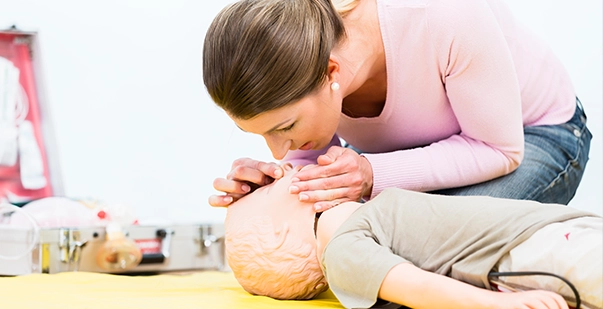
Last Updated on: November 26, 2024
Table of Contents:
Troubled breathing or a stoppage in breathing is an alarming situation. It often creates panic not only for the victim or patient but also for those around them. Troubled breathing may occur from any underlying disease, an accident, etc. Therefore, carrying out a timely first aid activity is necessary to help the individual sustain the situation and survive it. Roughly 40% of out-of-hospital cardiac arrest (OHCA) survivors receive CPR immediately from a witness, which increases the survival chances quite significantly.
In the case of halted and troubled breathing, mouth-to-mouth resuscitation is the easiest and fastest-adaptable approach when no other help is available to restore breathing. In this blog, we will discuss various aspects of mouth-to-mouth resuscitation and every necessary detail to remember in an alarming situation.
Mouth-to-mouth resuscitation is a method of providing artificial ventilation to a patient in need of emergency attention, usually outside a hospital. It is usually performed on patients who have trouble breathing or have stopped breathing.
The person who provides this kind of resuscitation or help is often referred to as a rescuer. In this method of providing ventilation to an individual in need of assistance in breathing, the rescuer places their mouth against the mouth of the patient and blows out a very large amount of air into the patient’s lungs. This stimulates the patient’s breathing, which results in the restoration of their internal respiration.
Mouth-to-mouth respirations are usually performed along with most Cardiopulmonary resuscitations (CPR) as a protocol for saving the life of those under cardiac arrest or similar critical event. However, there are certain cases where mouth to mouth breathing may be provided without giving chest compression, similar to that done in CPR.
Below is a list of a few conditions in which mouth-to-mouth resuscitation, along with chest compression, as in CPR, is necessary to restore an individual’s breathing.
However, there are cases when only mouth to mouth resuscitation without chest compression is required to be performed to restore the breathing of an individual in need. This includes conditions like respiratory arrest without cardiac arrest or failure of heart activity.
Read More: Head-Tilt/Chin-Lift Maneuver: How to Open an Obstructed Airway
Mouth-to-mouth resuscitation is achieved by the help of a rescuer forcing air into the lungs of the patient. The rescuer closely seals their mouth onto that of the patient. Then, the rescuer blows out a large volume of air into the patient’s lungs to help the patient initiate breathing.
Mouth to mouth resuscitation procedure has certain specific steps on how it should be performed. Performing each mouth to mouth resuscitation step correctly is crucial to ensure a positive outcome. Below listed are the main steps on how to give mouth to mouth resuscitation:
A similar variant of providing artificial ventilation mouth to nose resuscitation. In this method, the rescuer seals their mouth around the patient’s nose and blows strongly enough into it to provide airflow into the patient’s respiratory pathway. This method is performed when blowing into the patient’s mouth is not possible due to facial trauma or injury in or near the mouth.
Read More: Recognizing and Treating Paradoxical Breathing
Although mouth-to-mouth resuscitation is an emergency protocol, certain precautions need to be considered. This can help ensure that the resuscitation efforts will not go in vain or pose any risk to the rescuer. Make sure to note the below things when carrying out a mouth-to-mouth resuscitation.
A person must know the proper rules, steps and precautions of mouth to mouth resuscitation to carry it out effectively. Only individuals trained under proper guidelines can perform it to give a positive outcome. A rescuer must be trained properly to perform mouth-to-mouth resuscitation efficiently.
Proper mouth-to-mouth resuscitation during CPR helps sustain the patient’s breath until an AED is brought to the site of the event. An individual with proper knowledge of CPR mouth-to-mouth resuscitation can not only promise a better survival rate but also lower long-term complications. It also provides support during post-cardiac arrest care and plays a key role during cardiopulmonary resuscitation.